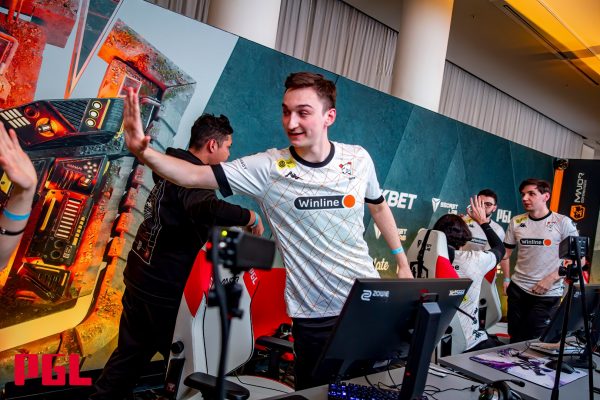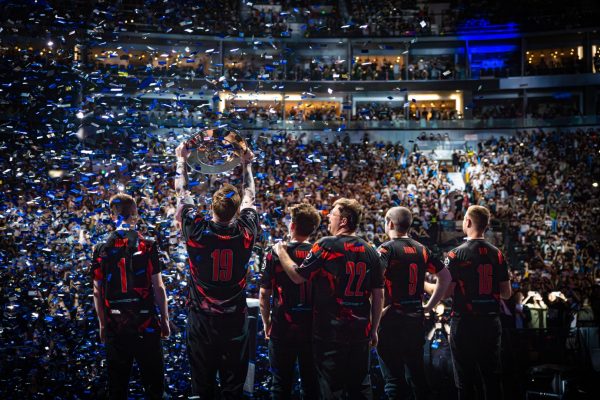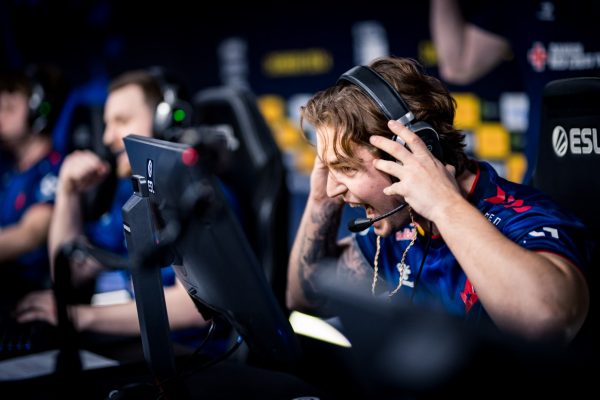Without question, 2020 has certainly been the strangest year for CS:GO, for esports, and perhaps for life in general. For fans of CS:GO, the ongoing global COVID-19 pandemic joined the lobby of life right as IEM Katowice began. By the time playoffs came around, the local Polish government had revoked ESL’s permission to host a crowd, and Na’Vi’s resounding 3-0 defeat over G2 Esports in the finals was performed in an empty arena.
One of the very few photo worthy moments of the year: Na’Vi victorious in Katowice. (Photo courtesy ESL)
After Katowice, CS:GO, like most other esports, moved entirely to a strictly online environment. But the lack of crowds and LAN connections didn’t result in a lack of theatrics, stories, and some damn good Counter-Strike. Here are the defining CS:GO moments from 2020.
NA CS’s Wild Ride
Toward the end of 2019, North American Counter-Strike was back on the rise. Team Liquid were coming off of a record breaking year, having won the Intel Grand Slam in four straight events (IEM Sydney, DreamHack Dallas, ESL Pro League, and ESL Cologne), as well as a myriad of other tournaments to fill a rather impressive trophy case. Evil Geniuses rejoined Counter-Strike after a long hiatus by acquiring the NRG roster, and impressed early with wins at IEM New York and StarSeries Season 8.
Ideally, the top-heavy region was set to expand in 2020, with a steady volume of CS:GO players and lower-tier teams available to help the scene thrive. Instead, it nearly collapsed in on itself.
With the pandemic restricting teams like Liquid and Evil Geniuses from competing overseas, the strictly regional tournaments have illuminated the problems facing North America. Several organizations once known for being NA stalwarts, such as Complexity and the once beloved Cloud9, have abandoned the region in order to pursue the bigger prize pools and more promising talent of Europe. And many of the players who were to be the next great wave of NA CS stars have instead left on a new adventure all together in VALORANT.
The two top teams haven’t swept through domestic competition like many expected. Evil Geniuses won just a couple of events over the summer, and Liquid haven’t had a first place finish since April on top of losing their mainstay in nitr0. The NA events have almost entirely been conquered by FURIA, who have risen to the top of Brazil following MiBR’s fall.
The only notable exception was IEM Beijing North America, in which both Team Liquid and Evil Geniuses fell in the semifinals to Triumph and Chaos EC, respectively. What was a crowning achievement for the eventual winner in Chaos, and what should have been the ultimate push into the upper echelons of competitive CS:GO, ended up being a final song before departing the stage with no encore, as Chaos EC abandoned Counter-Strike altogether, leaving the players’ futures in question. Chaos was not the only NA team to leave this year: 100 Thieves released the roster they acquired from Renegades, just a year after picking them up and moving to NA, citing a lack of stability in the scene. Many questions still remain, and the conversation about NA’s future has dominated the latter half of the year.
The Coaching Spectator Bug Spectacle
As the summer was winding down, the heat was turned way up when a new controversy rocked the CS:GO scene at the end of August 2020. ESL announced the bans of three prominent coaches for use of an in-game spectator bug that allowed the coach to view any spot on the map with a freelooking camera, including enemy bombsites and spawns. This included Heroic’s coach HUNDEN just days after arguably the organization’s biggest win at ESL One Cologne. It also included dead from MiBR, which led to the core of their roster being benched/released just a couple of weeks later.
Mousesports coach Rejin was removed from the team after it was revealed he’d used the bug while coaching a previous team. (Photo courtesy Starladder)
The ESIC then released a report in September outlining multiple instances of the bug being used, and handed out a massive 37 total bans to various coaches, including ones from prominent organizations like FaZe Clan, Na’Vi, North, Ninjas in Pyjamas, and others. Ban lengths ranged from as short as five months up to two years, with the exception of the most notable aggressor, former Hard Legion coach MechanoGun, who received three years.
The revealing of such a rampant issue prompted many questions from pros and fans in the community: were the wins that took place as a result of this exploit diminished or nullified? Should the teams have taken more responsibility? Was Valve at fault for allegedly being aware of the issue but not fixing it? Regardless, the reports and bans that arose from the controversy dominated the CS:GO landscape for months, and were a dark spot on the scene.
The Sixth Man Has His Breakout
During such a strange year, lots of teams opted into an experimentation phase, and began testing the notion of six-man rosters. After bringing in reserves solely for the point of giving their starters some time to rest and recuperate, Astralis seem content with retaining Lucas “Bubzkji” Andersen as their sixth man. In addition, Vitality acquired Nabil “Nivera” Benrlitom from Team Heretics, and have been swapping him in during certain scenarios.
Both teams found success with this method at the recent BLAST Fall Finals. Nivera filled in for either shox or mistusaa when it came to Inferno or Dust2, and at least one or sometimes both of these maps were featured in their winners’ bracket victories over mousesports, Na’Vi, and BIG. Bubzkji can be considered Astralis’ nuclear option, as he was subbed in for Xyp9x on three different occasions on Nuke, winning two of them. When the two teams met in the grand finals, Vitality removed Bubzkji from the equation with a ban of Nuke, and while they lost a close 16-14 affair on Dust2 to send the series to a decisive Inferno, Nivera was part of a three-headed monster alongside ZywOo and RpK that dominated the third map 16-5.
The track record for the substitutes in 2020 CS:GO was very impressive at BLAST Fall: 2-for-3 for Bubzkji on Nuke for Astralis, and 6-8 for Nivera on both Dust2 and Inferno. Astralis also utilized him to win DreamHack Winter; injecting him in both the semifinals and the grand finals. G2 appeared to be considering a six-man roster for a while, but instead opted for a traditional five-man by benching JaCkz following their NiKo acquisition. But if teams as synonymous with winning like Astralis and Vitality continue to find success with this method, then 2021 could see more upper-tier teams look to bolster their benches with map specialists.
Final Thoughts
When the world slowed down this year, esports pressed on. I know it’s funny to laugh at sports personality Stephen A. Smith’s remarks at The Game Awards, but he was right about esports’ ability to immediately pivot and push forward. And the stories above are just a portion of what we got to experience as fans of Counter-Strike.
We got to see teams like FURIA, Heroic, and BIG take huge steps forward. We saw a Complexity juggernaut unleash a massive BLAST, and inspire a potential new colossus of a rival in Cloud9. We saw one of the game’s best players change jerseys while reuniting with family. We said goodbye to some of the game’s stars as they undertook a new challenge. We even got a new Operation right at the buzzer.
2020 wasn’t a gnarly bump in the road, it was a stepping stone on the path to the future of Counter-Strike.


